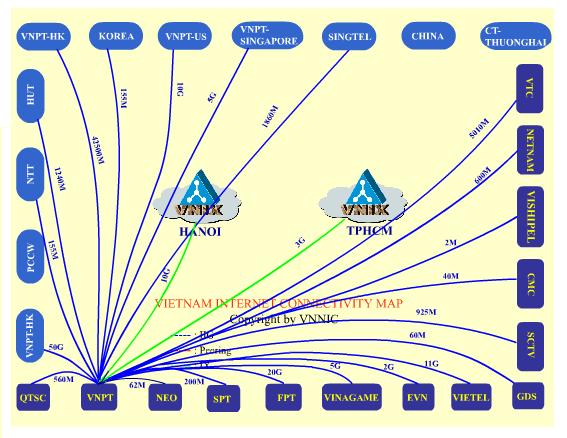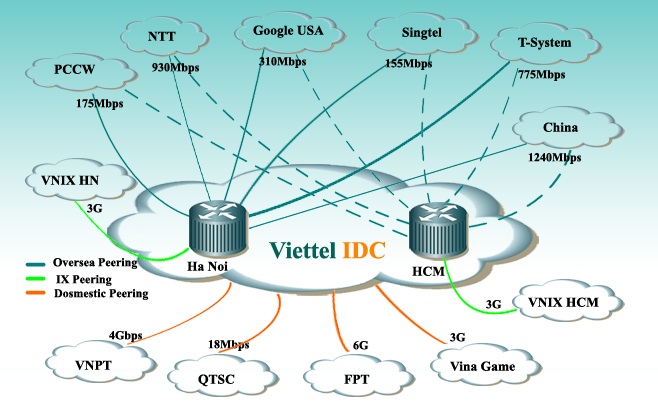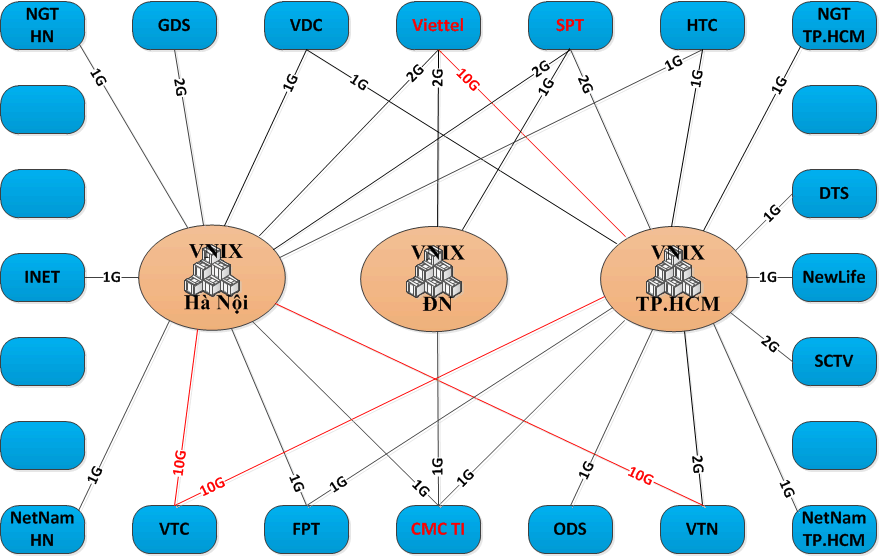internet
Vietnam has been labeled an "enemy of the Internet" by Reporters Without Borders. There have been a lot of cases of bloggers being targeted, harrassed, and arrested. But RSF (Reporters Sans Frontieres - French for Reporters Without Borders) are possibly speculating heavily on many of their other arguments such as banning Internet (gaming) cafes near schools, the real origins of DDoS attacks, Considering Internet penetration in this rather populous country, with Internet usage continuing to rise rapidly each year, and an explosion of Vietnamese businesses operating on the web, it might be a bit of hyperbole to say that Vietnam and the Internet are enemies, just like people mistakenly still think that Vietnam and America are still enemies. But censorship of websites is an issue here in Vietnam. It's an issue in all of Vietnam's neighbors in Southeast Asia.
First, to the north of Vietnam lies the vast Middle Kingdom of China (China isn't properly part of Southeast Asia but it does border many Southeast Asian countries). China has been labeled #1 Enemy of the Internet for implementing a technologically advanced firewall (the Great Firewall of China). In China, hundreds of popular American websites are blocked including Google, YouTube, Facebok and Twitter. Search queries are also monitored for keywords and then stopped if a person is searching about a sensitive topic like the Tiananmen Square massacre. Chinese are forced to use local versions of social media (like Sino Weibo) which are more easily controlled by the Chinese government. You could try to draw parallels to Facebook versus Zing Me and other social networks in Vietnam but the huge difference is that Facebook is still accessible and the one and only social media platform in Vietnam. TOR (The Onion Router, used for anonymously browsing the Internet and TOR .onion sites) is also blocked in China.
Malaysia isn't your typical enemy of the Internet. Its government (like Vietnam) encourages a digital ("multimedia", a term from the 1990s) economy with various initiatives like Cyberjaya and the Multimedia Super Corridor and when those initiatives started, just as the Internet was blowing up around the world, the government declared that the Internet was to remain free and uncensored. But Convervative Muslims in charge do want to limit certain cultural shortcomings by censoring scenes in movies with nudity or even just cleavage and sex or even just kissing.
Singapore - the country where chewing gum is banned and could get you caned. It's also a country with a rather long blacklist of blocked websites, mostly porn sites like YouPorn or Pussy.com. In Vietnam, pornography is illegal and you won't find Playboy or other girly mags being sold at magazine stands. But online, while ostensibly the Internet censorship laws are for blocking online porn, no porn sites are actually blocked (I've checked some of them - for research purposes). In Singapore, to a lesser extent, bloggers have been shut down and so has a random website about traveling while infected with HIV due to unfavorable portrayal of Singapore's policies towards HIV carriers. But no reports of bloggers being jailed unless they were also jaywalking, chewing gum, dancing in public places without a proper permit, bringing durian onto busses, or being a graffiti artist.
Thailand demonstrates a tactic that has been used in Vietnam, Cambodia, and probably many countries. Websites are not strictly speaking made illegal by the government. Rather, the government makes secret requests to ISPs to make certain websites unavailable. ISPs can decide to comply or ignore the request but ignoring the request comes at a high cost and so ISPs will generally block any website upon request. This means now over 100,000 websites are blocked in Thailand, putting it in the same league as China! Out of the rest of the countries in the region Thailand and Cambodia are the only kingdoms. Thailand has lese majeste laws making it illegal to insult the monarchy. This has led to arrests of people saying potentially offensive things about the king on social media sites like Facebook or even for liking or retweeting such statements.
Cambodia follows Thailand and Vietnam's leads when it comes to Internet censorship (Cambodia also gets their Internet connection from those two countries). When the government "requests" that certain websites are blocked the ISPs generally comply making it unnecessary to outright criminalize the websites in Cambodia. At the same time, governments deny censoring any websites and ISPs also release confusing messages regarding any block or whether it's an official block or just "technical difficulties". Like in Vietnam, certain blogs hosted by massive blogging platforms like Blogger and Bloghost have caused both entire platforms to be blocked by ISPs, not just the offending blogs. A certain controversial artists has had his website blocked, as has the NGO Global Witness, who fights againgst natural resource exploitation, corruption, and human rights abuses, probably for writing stuff like Cambodia should not stand for UN Security Council until land grabs and repression stop. Strangely, the prime minister of Cambodia briefly banned smartphones and 3G due to the potential of being able to view sexy streaming videos on one's mobile phone.
In Burma, the problem isn't just that some websites are blocked. Rather, all websites are slow and access can be unbearably limited to the point where they are functionally blocked. In general, Internet access is hard to subscribe to and then expensive to use, unaffordable for most Burmese. They also apparently have the same networking gear used for censorship as in China. With recent changes in attitudes towards the West and to media, with promises of no longer censoring newspapers, this is one country to watch in the future from any angle.
Laos, on the other hand, appears to not censor anything on the Internet.
On my most recent trip to Cambodia I bought a Cambodian SIM card so that I could both make calls and use the Internet on my smartphone. At the Moc Bai/Bavet border are a number of Khmer people (who speak Vietnamese) hanging around offering to change money into Cambodian Riel from Vietnam Dong (or US dollars). They also sell sim cards for around 60k VND ($3) which gives you a few dollars worth of calls. They can also cut the SIMs into microsims for iPhones.
I got a MetFone sim but my Vietnamese Mobifone sim actually worked while in Bavet and didn't lose signal until we were a few kilometers from the border. When I eventually lost signal and switched in the new MetFone sim, however, I wasn't able to get on the internet with either GPRS or 3G. And even when I arrived in Phnom Penh I couldn't find anyone who knew how to activate 3G and MetFone's website was not accessible.
Here are the instructions for anyone who wants to activate 3G on their MetFone sim card.
1) Send "3G ON" or just "ON" as a sms to the number 133. This enables 3G for your account. But you still need to set up your phone to use their APN.
2) You can have MetFone configure your smartphone by sending a special configuration file but you need to know the name of your handset according to MetFone. You can guess it but if you guess wrong you won't receive anything or you'll receive a configuration file for the wrong phone.
Send "MI " to the number 111. For a Sony Ericsson P900 the handset code is P900. For an LG Optimus Black the code is P970. It is the code name your manufacturer uses for your phone.
3) If you can't figure out the right handset code or MetFone doesn't know about your phone then you can configure it manually.
Go into your connection settings and set up an APN.
Input information APN: Metfone
Username: Metfone
Password: No
Input code 1111 ( if handset request) and reset again.
0) When you need to check your balance to see how many phone credits or how many kilobytes of data you can transfer, dial the code "*097#". This will send a command to your carrier and you'll get a message back immediately.
You may also need to reset your phone after enabling 3G or setting up your APN.
Note that 3G coverage in Cambodia is very spotty compared to Vietnam (even though MetFone is from Vietnamese military company Viettel). Speed can be decent but you may lose connection even without moving. This applies to Phnom Penh. Like Vietnam, most hotels have free wifi although many cheap guesthouses don't. When looking around for hotels in Phnom Penh be sure to ask first. My tips for finding a hotel in Vietnam also applies to Cambodia.
- tomo's blog
- Login to post comments
- Comments
If you ask Vietnamese officials, you'll hear such hyperbole as "the Internet service development in Vietnam is in no way inferior to developed countries in the world" (Mai Liem Truc, former Deputy Minister of Post and Telematics). But when people say such things and thus denying the existence of any problems they are leaving no room for improvement.
Yes, we have high speed internet and even fiber to the home (FTTH), both at relatively low costs compared to developed countries, though also not as fast as connections from homes to ISPs in Korea or Japan. We have 3G (but not LTE or 4G) also at very cheap prices - prepaid packages from $2 a month, even cheaper for a week or a day (you have to get used to the idea of being able to buy a single use ketchup packet of shampoo, $1 worth of credit for a phone, and a day's worth of data). Satellite connections exist although general ISPs don't offer them. Vietnam even has an indigenous satellite program (but they transmit to Earth at pitiful data rates thus not being suitable for general consumers).
But all methods of accessing the Internet are limited by Vietnam's links to the outside Internet where most of the content lies, since homegrown content in Vietnam is lacking compared to the English-language Internet both in quantity and quality. We have limited terrestrial links to China, and otherwise we have to rely on undersea cables from stations in Vung Tau and Da Nang to major regional undersea cables that connect Vietnam to neighboring Hong Kong or Singapore and points beyond. Some of these cables start in Europe and go through the Middle East. Others simply connect us to Japan and then the US.
When the Internet isn't super slow due to undersea cable cuts, it could be broken locally for other reasons. Infrastructure is fragile. Wires often catch fire or get cut for other reasons (did I mention rats?). Power goes out. Having a laptop and 3G internet access is a backup plan you'll use often, but this isn't reasonable for companies of any size. Being able to say that there are fiber connections and 3G is just a show. The reality is that Vietnam's Internet is considerably inferior to developed countries qualitatively.
On Censorship. One thing I've learned from talking to many mainland Chinese people is that they don't realize Internet censorship is a problem or that it's a bad or undesirable thing. Although not exactly the same, Vietnamese people similarly don't take a tone of offense at the idea of the government or really anyone imposing their restrictions on them. Or people take a light view of it, considering the easy of circumventing previous Facebook blocks. But this also leads to the Vietnamese Internet's lack of local content (and thus overdependence on international links). Creative people are not encouraged to produce content. Writers are jailed. Musicians and film directors have no protection for their works, sometimes even less than foreign works in Vietnam. So anyone who wants to take full advantage of the Internet right now and into the foreseeable future must learn English.
- tomo's blog
- Login to post comments
- Comments
Telecommunications in Vietnam visualized with some network maps showing both international and domestic peering arrangements between ISPs. Bookmark this page and I'll add more maps as I find them.
For international bandwidth VNPT (VDC) is important. For domestic internet look for connections through VNIX. VNPT, FPT, Viettel, NetNam, SPT, even VinaGame and Google.




Information about server hosting in Vietnam
Information about cloud hosting and content delivery network access from Vietnam
I've been doing some testing on a plethora of content delivery networks using cloudharmony.com's speedtest service. Testing from multiple ISPs in Vietnam, during the most recent undersea cable outage, it becomes clear that, although none of the CDNs publicly have datacenters in Vietnam, a small handfull of networks like Edgecast CDN (via http://www.speedyrails.com/) come out on top as winners (except for an anomalous reading of small file size downloading from one ISP). In these tests, performance of poor hosts relative to the top was as much as 20 times slower, meaning CDN selection without taking into consideration the real world results in Vietnam can mean you're throwing a lot of money away. Poorly performing content delivery networks were more or less not any faster than hosting in the US.
Limelight CDN also had some of the best overall results, better than Edgecast in some cases.
VoxCAST CDN had a surprisingly low latency time suggesting it could be closer to Vietnam than anything in Singapore, but VoxCAST (Internap) do have a Singaporean datacenter which is probably just faster than other points in Singapore. Unfortunately, the transfer speeds were too low. Internap's CDN taken into consideration alone fared poorly. Edgecast state they use Equinix Singapore Exchange so it may be worth looking into colocating there.
Windows Azure CDN had some promising results in some tests whereas other tests failed. I didn't investigate further when CDNs failed, assuming they should not fail.
What may be more surprising is who isn't the winner here: Amazon
Amazon EC2 instances in both Singapore and Tokyo (just for comparison) performed poorly both in terms of latency and throughput. Amazon's CloudFront service did no better.
Asia-America Gateway undersea cable outage
At the time of writing, the AAG internet cable that connects to Vietnam at Vung Tau's landing station, thus providing FPT (although Viettel and VNPT do also use AAG) in Ho Chi Minh City and its subscribers with international bandwidth to Hong Kong, Singapore, and points beyond in the US, has been cut or damaged again. The cable experiences cuts both at the Vung Tau cable landing station as well as in the main trunk when all traffic along the cable would be affected. It is one of several international links to Vietnamese ISPs such as SEA-ME-WE 3 (but not SEA-ME-WE 4) which connects to Vietnam in Da Nang and links Southeast Asia with East Asia, Australia, the Middle East, and Western Europe. TVH and TGN-Intra Asia Cable System also land in Vung Tau connecting Southern Vietnam to the greater Internet. Vietnam also has terrestrial internet connections to China.
[Update: The AAG cable is being repaired from October 25, 2012 until November 4.]
I used to run a hosting company back in the states. I wouldn't want to get into that business again as it's capital-intensive (for a tech company) and highly competitive.
Looking at the server colocation market in Vietnam it seems small and expensive for what you get, and maybe there is far more demand from Vietnam-based businesses to host in the US because that's where their customers are. But companies that aim for the domestic market need to consider hosting locally since the Internet link to the US is relatively narrow and expensive with high latency.
When I searched for colocation servers in Vietnam, the #1 result, vn84.com, was down; webhosting.com.vn's account has been suspended; aacecom.net is now a parked domain just showing ads. Not very good results.
After distilling the first 100 or so results on Google:
Conclusion: FPT is definitely a stable business, yet prices aren't out of line, with higher upload speeds. It's always best to avoid anything priced in USD since the Vietnam dong is certainly going to weaken against the dollar soon. But even the cheapest colo at 1.3 million VND is more than I can lease a dedicated server for in the US.
So how much are dedicated servers at these places?
Oddly, for pavietnam.com the price to lease a dedicated server is cheaper than to buy and colo your own!
Virtual Private Servers are another option. Let's compare:
They come out to roughly a third of the cost to colo. You'd be better off finding a friend to chip in and get pavietnam's dedicated server deal.
UPDATE April 3, 2012:
There are a lot of small providers in Vietnam outside of the big ones listed above. If you want to check some out, many even have free trials. Check out the forum at vn-zoom.com if you can read Vietnamese.
For colocation, Viettel's IDC "Sóng Thần" datacenter in Binh Duong is the largest in Vietnam, and possibly all of southeast Asia.
When considering Singapore as an alternative hosting center, be aware that generally prices for VPSs in Singapore are significantly higher than what you would pay in the US, while latency is still around an order of magnitude (10x) that of a Vietnam-based host, while still 1/2 to 1/3 of a North American host. YMMV.
Recent comments
1 year 11 weeks ago
2 years 3 days ago
2 years 1 week ago
2 years 3 weeks ago
2 years 19 weeks ago
2 years 19 weeks ago
2 years 19 weeks ago
2 years 19 weeks ago
2 years 19 weeks ago
2 years 19 weeks ago